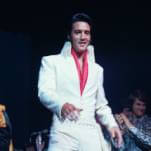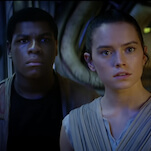Valentine’s Day may have been two weeks ago, but love is still in the air at Marvel this week thanks to Matt Fraction’s FF and Hawkeye. Both titles deliver romance comics with a twist: FF presents a courtship as a madcap superhero comedy, and Hawkeye puts the hero’s relationship troubles through a gritty crime filter. They fall on completely different ends of the superhero-comic spectrum, but are similarly exhilarating reads, showing an astute understanding of the comic-book form and genuine interpersonal dynamics.
The romance-comic influence is heaviest in Hawkeye, which features mock covers by Annie Wu in the style of classic titles like Young Romance and Sweethearts. The issue opens with Clint Barton on the cover of Doomed Love, looking aloof while all the women in his life surround him in little hearts. That image comes into play after a spectacular silent sequence where Cherry shoots her ex-husband in front of his father. She flees to Avengers Mansion and kisses Clint while his coworker, ex-wife, and “Friend. Girl?” look on with expressions ranging from annoyance to horror. The panel of Cherry kissing the confused hero is accompanied by the narration that begins all of Clint’s adventures, “Okay… This looks bad,” and the rest of the story is told through graphic touches that establish setting and character.
The ornate glass “A” on the door, the cards falling out of Clint’s hand, his purple and gray street clothes, her minidress covered in bull’s-eyes; he’s Hawkeye the Avenger and she’s a walking target. The title lettering is the icing on the cake, with the italicized “My Bad Penny” printed over a heart with an arrow through it and “Bad” written in red to emphasize Cherry’s naughtiness. The background is all white so that these graphic elements are even more apparent, although the mansion floor is covered in black squiggles that visually reflect the confused anxiety in Clint’s mind at the moment. The side of the page is a vertical sequence of Lichtenstein-esque facial close-ups, building up to the reveal that Clint has been playing Indian Forehead with his three female associates.
David Aja provides a soundtrack for each issue in the letters column, and readers should definitely absorb the story with his mix of chill surfer rock, experimental Frank Zappa orchestrations, and moody jazz in the background. There’s a clear ’60s influence on Aja’s work (take a look at those outfits Natasha, Bobbi, and Jessica are sporting), but his storytelling is cutting-edge. His panel layouts expertly manipulate the passage of time, and he can slow down an intimate moment to give each second added resonance and speed up an action sequence to showcase Clint’s skill in battle. Annie Wu’s chapter breaks are a smart way of providing a rough outline of Cherry’s background, but they also serve a purpose in the narrative: The comics Cherry sends Clint are put in a specific order that is the combination for the safe he helps her steal.
The second half of the issue switches into the high-octane action that has become synonymous with this book, but Fraction still keeps the focus on Clint’s love life, even when he’s beating a bunch of thugs in tracksuits. “There’s gotta be a better way to tell my girlfriend the thought of a serious relationship makes me nervous,” he says as he foolishly works as muscle for the woman he’s sleeping with. The foolish things people do for love (or lust) is a recurring theme in both of Fraction’s books this week. Hawkeye shows the kind of insanity that follows when an adult with unsavory connections is an enamored idiot, but FF approaches the idea from the perspective of children living in an environment where their imaginations are the limit.
It’s not easy being a kid in superhero comics. Some child and teen heroes manage to gain enough popularity that they grow to be full-fledged adult heroes, but for every success story like Peter Parker and Dick Grayson, there are entire groups of heroes like the New Warriors and Teen Titans East that have been used as cannon fodder. Just looking at this week’s comics, we have DC’s best character, Damian Wayne, dying over in Batman Incorporated, and Marvel’s young heroes fighting to the death in Avengers Arena. Both of those comics are highly recommended reads, but it’s refreshing to see an all-ages book like FF with a cast of kids that act like kids and are probably not going to get killed off anytime soon. There’s no other superhero comic having as much fun as FF, and that’s largely due to the cast of children who keep things unpredictable while forcing the adult leads into new roles. Allred is also incredibly skilled at drawing kids; the students of the Future Foundation are always fidgeting and react with more exaggerated expressions than their teachers.
Fraction’s Fantastic Four and FF both have romantic plots at their center this month, with Fantastic Four finally clicking into place with a heartwarming look at Sue and Reed’s relationship. After the first issue set-up, each installment of Fraction’s FF has spotlighted a specific member of the team, and February is She-Hulk’s month. Part When Harry Met Sally, part Looney Tunes, “Escalation” is a delightful story about two ex-lovers rekindling their romance, and the drastic measures a group of obsessed children will go to quell the flames. They brainwash a waiter to do something unthinkable at the restaurant, and he comps Jen and Wyatt’s meal; they awaken the New Amsterdam leviathan Blarrgh, who does nothing but provide mood lighting; they try to burn down the bar where the couple grab drinks, but just heat up the room so that Wyatt unbuttons his shirt.
The page of Wyatt and Jen on the dance floor is Michael Allred at his ginchy best, showing the two dancing on top of a background covered in shoe prints, gradually getting closer with each new image. They start by doing the Batusi separately, then grab one hand for some playful light partnering. Once they have both hands on each other, their magnetism becomes nearly unstoppable, but Jen uses her Hulk strength to stop Wyatt before he plants a kiss on her. In a cute touch, Jen and Wyatt act like anxious children when they’re around each other, which is a nice contrast to the infantile behavior exhibited by her followers. The couple eventually grows up, though, when an infuriated Bentley throws the superheated Fantastic Core on the ground and accidentally blankets the neighborhood in an ethereal pink cloud. Wyatt can’t deny the romantic atmosphere and goes in for a kiss that Jen readily accepts.
Neither FF nor Hawkeye are titles that would be classified under the romance genre, but both of these issues show how valuable a little love can be in creating an emotional narrative. Both issues prove that taking the time to flesh out personal relationships doesn’t have to come at the expense of the ongoing plot, and Fraction realizes that if the personal conflicts are believable, the extraordinary elements of the story will be more powerful.








































